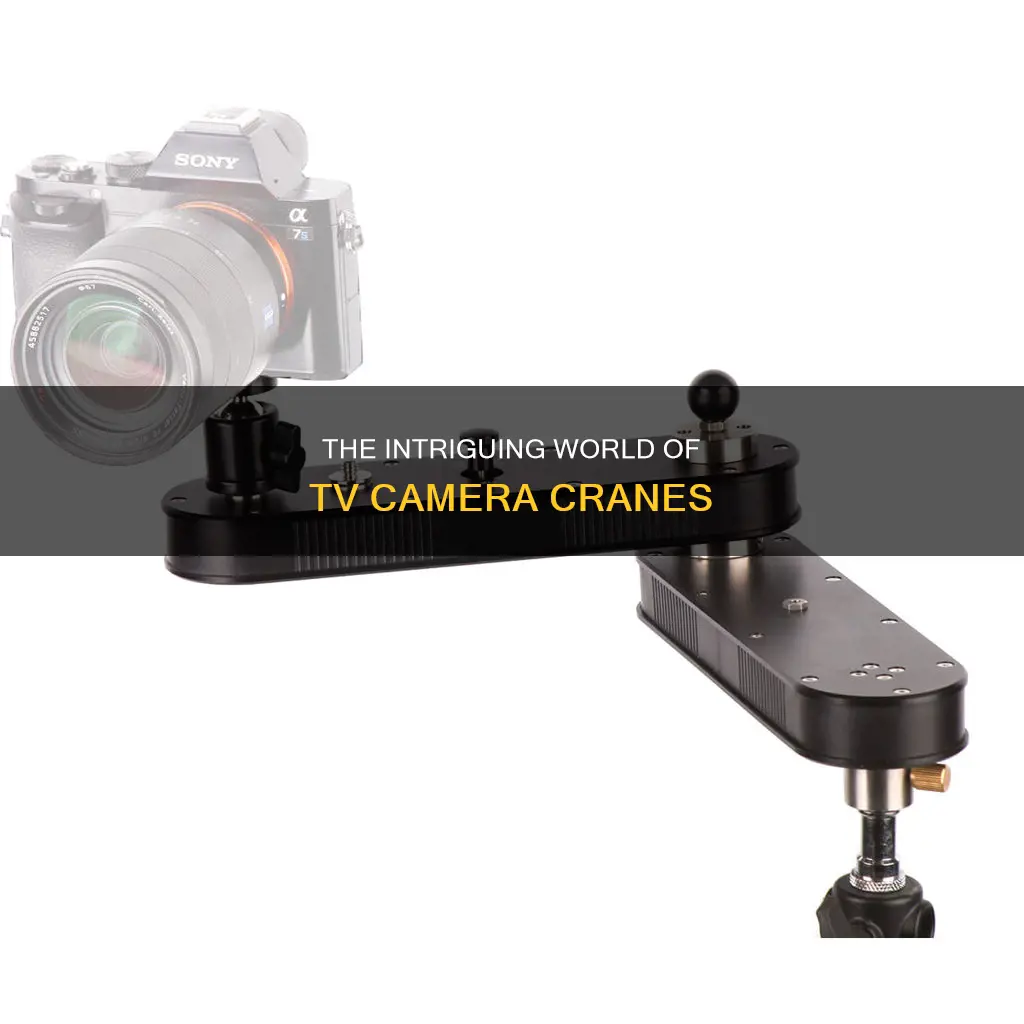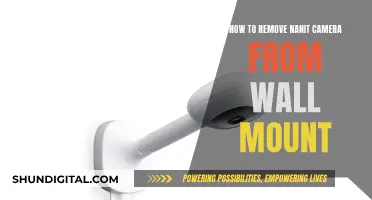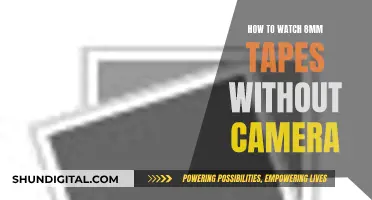
In cinematography, a device used to mount a camera on one end and a counterweight on the other is known as a jib. Jib arms can be used to capture shots that are difficult for handheld cameras, such as high or low angles, or shots that require horizontal or vertical movement. They can also be used to capture large crowds or establish dynamic cinematography. Jib arms can be controlled either mechanically or manually, and they come in a variety of sizes, with larger ones typically used in high-end productions.
| Characteristics | Values |
|---|---|
| Name | Jib, crane shot, or skycam |
| Description | Any boom device used to mount a camera on one end and a counterweight with camera controls on the other |
| Movement | Vertical, horizontal, or a combination of the two |
| Use case | Getting high or low shots, or shots that need to move a short distance horizontally or vertically |
| Mounting options | Mounted on a tripod or on their own support stands, often on wheels |
| Assembly | Modular and can be assembled in various lengths |
What You'll Learn

Jib/crane shots
A camera on an arm in TV is called a jib or crane shot.
Jib and crane shots are achieved using a camera jib—a piece of equipment that allows for dynamic and flexible camera movements that would be difficult, or even impossible, to do with handheld or tripod-mounted cameras. A jib is a type of boom arm that has a camera mounted on one end and a counterweight on the other, operating like a see-saw. The counterweight end is where the camera operator or remote control system is located, allowing them to pan, tilt, and move the camera along the length of the boom. This creates dramatic, sweeping movements that can move vertically, horizontally, or in complex arcs, all while maintaining a smooth and flowing motion.
Jib shots offer several advantages in filmmaking:
- Dynamism: Jib shots add a powerful sense of motion and visual energy that enhances the storytelling.
- Scale: They help establish a sense of grandeur or scope within a scene, such as revealing a breathtaking landscape or a bustling cityscape.
- Flexibility: Jibs can move the camera in ways that would be impossible with a dolly or crane, allowing them to swoop in close, gracefully move around obstacles, and add depth to a scene.
- Emotional Impact: The fluid yet powerful camera movement of a jib shot can evoke a range of emotions, from excitement and wonder to suspense and isolation.
Jib shots are commonly used in establishing shots, providing a bird's eye view of the geography and setting of the story. They can also be used to end scenes or films, either on a high note with a happily-ever-after shot or a tragic ending by highlighting the character's loneliness or fate. Additionally, jib shots are useful for showing large crowds or sets, capturing the actions of multiple characters in a single take, and showcase products or elaborate sets.
While the terms "jib" and "crane" are often used interchangeably, there is a technical distinction between the two. A jib refers specifically to the arm that extends out and provides the sweeping camera motion, usually mounted on a tripod or dolly for support. On the other hand, a crane refers to the entire system, which includes the jib, a base for stability (often wheeled), counterweights, and sometimes a seat for the camera operator. Therefore, not all jib shots are crane shots, but all crane shots are jib shots since they involve the use of a jib arm.
Feisty Pets and Cameras: Are They Watching You?
You may want to see also

Dolly shots
A dolly shot is a technique used in cinematography to create smooth and controlled camera movements. The camera is mounted on a wheeled cart, or "dolly", which can run on rails or its own wheels. This allows the camera to move towards, away from, or alongside the subject of the shot, such as an actor, location, or product. Dolly shots are often combined with other camera movements like pans or tilts to accentuate the theme or message of a scene.
There are several types of dolly shots, including:
- Dolly in and dolly out: The camera moves smoothly towards or away from the subject.
- Dolly zoom: The camera moves back and forth while also zooming in or out, amplifying the background and creating a visual and psychological effect.
- Dolly with secondary camera movement: Additional camera movements such as panning, tilting, or rolling are added to the dolly shot.
- Long tracking shot: The camera follows a character for a prolonged period without any visible cuts, often requiring a significant rail length.
- 360-degree dolly shot: The camera moves in a circular motion around the subject, providing a glimpse into the scope of the scene.
- Spike Lee dolly shot: Both the actor and the camera are on the dolly, creating a floating-like appearance as the actor moves through the scene.
Insignia Roku TV: Does It Have a Camera?
You may want to see also

Aerial shots
The first aerial shots were taken from balloons in the early 1800s, and the use of drones has since reinvented this technique. However, there are various ways to achieve an aerial shot, and filmmakers have used different equipment over the years, including helicopters, cranes, jibs, and planes. When it comes to TV, cable-suspended camera systems like Skycam have also been used to capture aerial shots of live events, such as sporting events and news coverage.
Using a crane or jib is a common way to achieve an aerial shot without needing a plane or helicopter. These devices feature a camera mounted on an elevated arm, allowing for dynamic perspectives and movement. Some cranes even have complex setups attached to a vehicle or dolly track, providing a range of movement options.
Drones have revolutionized aerial cinematography, making it more accessible and budget-friendly. They are easier to acquire than planes or helicopters and offer tremendous maneuverability. However, drone operators must comply with FAA regulations, register their drones, and obtain remote pilot certification for commercial use.
Planning is crucial for aerial shots, especially when using complex equipment or working with a large crew. Cinematographers must consider the equipment, scheduling, and movement within the shot to ensure a smooth and safe production.
Viewing Doorbell Camera Footage: TV Integration Options
You may want to see also

Tracking shots
The use of tracking shots adds a sense of movement and immersion, drawing viewers into the action. They are often employed to follow a subject that would otherwise leave the frame, such as an actor or vehicle in motion. Tracking shots can also be used to showcase a setting with rich detail, enhance the connection to a character, or emphasise the plot of a story.
Achieving the perfect tracking shot can be challenging and requires careful planning, blocking, and consideration of various factors, such as camera speed, stability, and duration.
Android Smartwatches: Camera-Equipped or Not?
You may want to see also

Overhead shots
A jib is any boom device used to mount a camera on one end and a counterweight with camera controls on the other. It operates like a see-saw, with the balance point located closer to the counterweight, allowing the camera end to move through an extended arc. A jib can be used to achieve high or low shots that would be difficult for a handheld camera operator to get, or shots that need to move a short distance horizontally or vertically. A small jib can be mounted on a tripod, while larger jibs have their own support stands, often on wheels.
Film cranes and camera jibs use a jib arm to extend a camera outward, enabling it to move up, down, left, or right in large movements. They are great for crane shots and camera boom movements, as well as establishing shots that show off the world of a film. Crane shots can also reflect a character's emotions as the camera moves away from them, often used in moments of helplessness and isolation.
Another way to achieve overhead shots is through the use of aerial cinematography, which has become more accessible since the invention of the drone. Drones can capture amazing footage of expansive landscapes, chase scenes, and establishing shots that would have been impossible before.
Big Brother: Government Surveillance and Our Cameras
You may want to see also
Frequently asked questions
A camera on an arm is called a jib or a crane.
A jib is a piece of filming equipment that allows camera operators to capture specialised shots that would otherwise be impossible.
A jib operates like a see-saw, with a camera mounted on one end and a counterweight on the other. This allows the camera to be smoothly lifted and lowered, while the counterbalance keeps the shot steady.
Jib shots are often used for establishing shots, ending shots, capturing a subject's actions, and showing large crowds. They can add dynamic movement to a shot and create a sense of intimacy or heighten intensity.
Alternatives to using a jib include handheld rigs, shoulder rigs, dollies, sliders, and stabilisers such as the Steadicam. Each type of rig offers different capabilities and limitations, and filmmakers choose the rig that best serves their creative vision.







